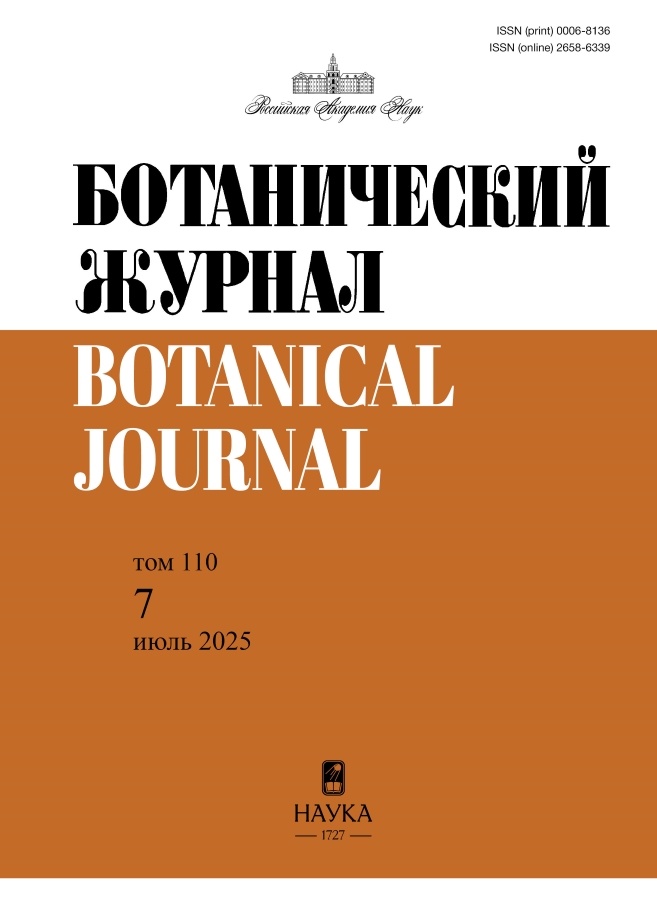Том 109, № 1 (2024)
ОБЗОРНЫЕ СТАТЬИ
Строение и развитие гамет в связи с оплодотворением у цветковых растений
Аннотация
В статье анализируются данные по процессам, которые происходят до и после оплодотворения у цветковых растений. Гаметы формируются на стадии гаметофита из гаплоидных микроспор и мегаспор. Они представлены спермиями-клетками, яйцеклеткой и центральной клеткой. Слияние мужской и женской гамет происходит после проникновения пыльцевой трубки в любую из синергид. Один спермий сливается с яйцеклеткой, а второй из той же пыльцевой трубки объединяется с центральной клеткой.
У покрытосеменных растений вероятно существуют четыре типа оплодотворения. Эти типы различаются степенью завершенности процесса сингамии. Премитотический и постмитотический типы характеризуются завершением сингамии, в то время как андрогамному и гинандрогамному типам присуща незавершенная сингамия. Важное значение в этом случае приобретает поведение ядер спермиев-клеток. Как правило, они объединяются с женскими гаметами (премитотический и постмитотический типы оплодотворения), однако ядра спермиев могут оставаться автономными (гинандрогамный тип оплодотворения) или ядро женской гаметы после разрушения может быть замещено ядром спермия (андрогамный тип оплодотворения). При премитотическом типе оплодотворения протопласты гамет (плазмогамия) объединяются до начала митоза в ядре зиготы. Что касается постмитотического типа оплодотворения, то он осуществляется на совершенно иной основе. Возможно, что у цветковых растений хромосомы ядер спермия и яйцеклетки не сливаются во время митоза. В дальнейшем они делятся независимо, а диплоидный набор хромосом возникает на стадии 2-клеточного зародыша.
 5-30
5-30


ОРИГИНАЛЬНЫЕ СТАТЬИ
Движение хлоропластов в клетках мезофилла Pinus sylvestris (Pinaceae) инициируется низкой температурой: SBF SEM 3D-реконструкция
Аннотация
Вечнозеленые виды умеренной зоны приспосабливаются к сезонному климату за счет реорганизации структуры клеток мезофилла, включая передвижение хлоропластов как фотозащитную реакцию. Однако фактор, вызывающий структурные изменения, до сих пор остается неизученным. С целью выявления особенностей расположения хлоропластов в течение годового цикла и влияния температуры на их движение было изучено строение клеток мезофилла Pinus sylvestris, выращиваемых в открытом и закрытом грунте. Серийная блочная сканирующая электронная микроскопия (SBF SEM) использовалась для трехмерной реконструкции клеток мезофилла, чтобы показать пространственное положение и изменение формы хлоропластов. Выявлено, что в течение вегетационного периода хлоропласты имеют хорошо развитую тилакоидную систему, располагаются вдоль клеточной стенки и занимают преимущественно ту часть клеточной стенки, которая обращена к межклетникам. Движение хлоропластов начинается в октябре-ноябре, а зимой они группируются в складках клеток мезофилла. В это время тилакоидная система перестраивается и состоит преимущественно из длинных cдвоенных тилакоидов и мелких гран. 3D-реконструкция показывает, что хлоропласты ориентированы в случайном порядке, увеличивают объем стромы и образуют множественные выпячивания, заполненные стромой, которые можно распознать как стромулы. У растений, выращенных в условиях оранжереи, сезонная реорганизация ультраструктуры мезофилла не происходит, что позволяет предположить, что именно низкие температуры, но не фотопериод и качество света, индуцируют сезонное движение хлоропластов в мезофилле P. sylvestris. Мы подтверждаем, что 3D-реконструкция является мощным инструментом в изучении изменений положения и формы хлоропластов, вызванных низкой температурой.
 31-43
31-43


СООБЩЕНИЯ
Распространение и особенности биологии Magadania olaënsis (Apiaceae)
Аннотация
Приведены сведения о распространении в Магаданской области, фитоценотической приуроченности и некоторых особенностях биологии Magadania olaënsis (Gorovoi et N.S. Pavlova) Pimenov et Lavrova – редкого вида, включенного в Красную книгу РФ, представителя олиготипного рода Magadania, эндемичного для севера Дальнего Востока России. Выявлена площадь ареала вида, составляющая около 390 км2, подготовлена карта его распространения, дана оценка численности (примерно 4–8.5 тыс. экземпляров). Охарактеризованы биология и сезонный ритм развития M. olaënsis – многолетнего монокарпика, для которого характерна нестабильная семенная продуктивность. Семена прорастают только после длительной стратификации. Описаны местообитания и основные растительные сообщества, в которых вид произрастает. Даны рекомендации по мерам охраны M. olaënsis.
 44-66
44-66


Полиморфизм геномной ДНК Myrica gale (Myricaceae) на территории государственного природного заказника “Лебяжий” (южное побережье Финского залива)
Аннотация
Анализ полиморфизма геномной ДНК – один из широко используемых подходов при изучении генетической структуры природных популяций. Его успешно применяют к различным видам растений. Но многие виды пока практически не исследованы, что в первую очередь связано с методическими сложностями при выделении хорошо очищенной геномной ДНК. Эти сложности связаны с тем, что для растений характерны многочисленные органические соединения (полисахариды, полифенолы, липиды и т.п.), загрязняющие ДНК и значительно снижающие ее качество. К числу таких видов относится восковник болотный (Myrica gale L.) – многолетний приатлантический кустарник, размножающийся главным образом вегетативно (проростки восковника встречаются в природе очень редко). Мы разработали простой протокол выделения высококачественной геномной ДНК из листьев восковника и провели AFLP-анализ 42 растений этого вида из трех субпопуляций на территории природного заказника “Лебяжий”. Использовав три пары праймеров, вычленили 22 фрагмента амплификации, 8 из которых оказались мономорфными. По остальным 14 фрагментам средний уровень их полиморфизма был невысок: в зависимости от исследованной субпопуляции он варьировал от 0.079 до 0.129. Как показал проведенный нами анализ, все три исследованные субпопуляции восковника оказались полиморфными с преобладанием двух общих AFLP-генотипов. По-видимому, соответствующие растения являются вегетативными потомками основателей данной популяции. Обнаруженные редкие AFLP-генотипы (представлены всего одним или двумя растениями; в общей сложности таких генотипов выявлено 12), вероятно, возникли в результате мутационных и рекомбинационных процессов. Полученные данные свидетельствуют о том, что в воспроизведении и расселении восковника роль полового размножения тоже существенна.
 67-82
67-82


Сравнительный морфологический и генетический анализ популяций Corydalis bracteata sensu lato (Papaveraceae) из Южной Сибири
Аннотация
В работе впервые проведено изучение морфологического и генетического разнообразия 6 популяций Corydalis bracteata Pers. s.l., произрастающих в растительных сообществах Красноярской лесостепи, Западного Саяна, Кузнецкого Алатау, Алтая. В ходе морфологического анализа выявлено разделение совокупности популяций на две группы. Наличие крупного вытянутого дополнительного клубенька в пазухе прикорневой чешуи, крупные размеры прицветника и цветков, максимальная высота растений сближают особи из красноярской и западносаянской популяций с недавно описанным видом Corydalis talpinа Stepanov – хохлаткой кротовой. Эти результаты подтверждаются и проведенным ISSR-PCR анализом генетической изменчивости популяций хохлатки. Высокие значения коэффициента подразделенности популяций (Gst = 37.58%) свидетельствуют о наличии в общей выборке разных видов. Разделение на две группы также продемонстрировано при построении дендрограммы и при кластеризации генотипов с использованием байесовского подхода, реализованного в программном обеспечении STRUCTURE 2.3.4. Секвенирование последовательностей хлоропластного гена matK и межгенного спейсера rpoB-trnC показало, что растения из популяций СB1 и CB2, выделяемых нами в вид C. talpina, отличаются от других образцов тремя видоспецифичными нуклеотидными заменами (SNPs), одна из которых – миссенс-мутация. Согласованные результаты морфологического и генетического анализов свидетельствуют о дифференциации популяций желтоцветковых хохлаток из Южной Сибири, изначально относимых к виду C. bracteata, и указывают на морфологическую и генетическую обособленность C. talpinа.
 83-98
83-98


ФЛОРИСТИЧЕСКИЕ НАХОДКИ
Artemisia verlotiorum (Asteraceae) – новый вид для флоры Азербайджана
Аннотация
Впервые во флоре Азербайджана (Большой Кавказ западный, Малый Кавказ северный, Ленкоранская низменность и Апшерон) выявлен новый инвазивный вид Artemisia verlotiorum Lamotte. Приведены сведения относительно обнаруженных популяций вида, их численности, занимаемой площади, а также краткое описание фитоценозов в местах произрастания.
 99-102
99-102


ХРОНИКА
III Всероссийская конференция с международным участием “Систематические и флористические исследования Северной Евразии” (к 95-летию со дня рождения профессора А. Г. Еленевского) (Москва, 19–21 октября 2023 г.)
 103-106
103-106












